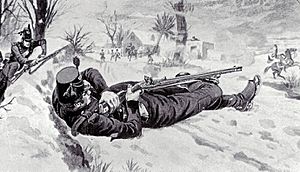Battle of Cacabelos facts for kids
Quick facts for kids Battle of Cacabelos |
|||||||
|---|---|---|---|---|---|---|---|
| Part of the Peninsular War | |||||||
 The French General Colbert was hit by a shot fired by Thomas Plunkett. |
|||||||
|
|||||||
| Belligerents | |||||||
| Commanders and leaders | |||||||
| Casualties and losses | |||||||
| 200 men killed or wounded |
|
||||||
The Battle of Cacabelos was a small but important fight during the Peninsular War. It happened on January 3, 1809, near the village of Cacabelos in León, Spain. British soldiers, led by Sir John Moore, were trying to retreat to A Coruña.
French forces, led by Marshal Nicolas Soult, caught up with them. The British had to quickly cross a bridge to escape. During the fight, the French lost their leader, Brigadier General Colbert-Chabanais. This loss slowed the French down. It gave the British army enough time to continue their retreat safely.
Contents
What Was the Peninsular War?
The Peninsular War was a big conflict in Europe. It lasted from 1807 to 1814. It was fought between France and the allied armies of Spain, Portugal, and the United Kingdom. This war was part of the larger Napoleonic Wars. The fighting in Spain and Portugal is known as the Peninsular War.
Where Did the Battle Happen?
Cacabelos is a village in a mountainous area of Spain. It is about 15 kilometers (9 miles) past Ponferrada. The village was right on the path Sir John Moore's army took to retreat to A Coruña. A stone bridge with two arches crosses the Cua River there. This river is a small branch of the Sil River. The bridge was a key spot for the battle.
The Battle Begins
Sir John Moore was camped at Villafranca. This was about half a day's march away. He had ridden back to check on his rearguard. The rearguard is the part of an army that protects the main group from behind.
The British rearguard had reached Cacabelos the day before. They were delayed by cold weather and some local unrest. They were getting ready to cross the bridge. Suddenly, soldiers from the 15th Hussars (a British cavalry unit) reported that French cavalry were coming fast from Ponferrada.
French Attack
Soon, about 450 to 500 French cavalry soldiers arrived. These were from the 15th Chasseurs à Cheval and 3rd Hussards. They were Marshal Nicolas Soult's advance guard, led by Brigadier General Colbert-Chabanais. They surprised the British, capturing about 50 soldiers.
General Colbert decided to attack the bridge right away. He didn't wait for his infantry (foot soldiers) or artillery (cannons) to arrive. However, he saw British soldiers ready on the other side of the bridge. These included the 95th Rifles, the 28th Foot, and six cannons from the Royal Horse Artillery.
British Defense
Colbert pulled his men back to get ready for a charge. Meanwhile, Sir John Moore and Edward Paget watched from a nearby hill. Moore himself had almost been captured by Colbert's men.
When the French cavalry charged across the bridge, the British riflemen opened fire. The French were hit hard and had to retreat. General Colbert was killed during this attack. His death was a big blow to the French.
Nightfall and Retreat
Later, more French soldiers arrived, including cavalry led by La Houssaye and infantry led by Merle. They tried to cross the river. Some tried to find a shallow spot (a ford) downstream from the bridge. Others tried to take the bridge with bayonets (knives attached to rifles).
However, by 4:00 PM, it was getting dark. The French stopped their attack. They might have thought the British defense was too strong. Also, the death of General Colbert likely lowered their spirits. Around 10:00 PM, Edward Paget and the British rearguard were able to leave for Villafranca. The French did not follow them.
The Famous Shot
Brigadier General Colbert-Chabanais was killed by a single shot. It was a long-range shot from a Baker rifle. The shot was fired by Thomas Plunket, a skilled sharpshooter from the 95th Rifles. Plunket also shot and killed the officer who came to help Colbert.
People disagree about how far away Plunket was. Some stories say it was as far as 600 meters (about 650 yards). A regular musket could only hit targets accurately up to about 80 meters (87 yards). The Baker rifle was much better, with accurate shots up to 200 meters (218 yards). Colbert likely thought he was safe from British fire, but Plunket's rifle was special.
What Happened Next?
The Battle of Cacabelos helped the British army gain time. They were able to continue their retreat towards A Coruña. However, some people have criticized Sir John Moore. They believe he retreated too quickly. They also think he could have used strong defensive spots like Cacabelos even better.
The Corunna campaign continued after this battle. The next major event was the Battle of Corunna.
See also
 In Spanish: Batalla de Cacabelos para niños
In Spanish: Batalla de Cacabelos para niños

